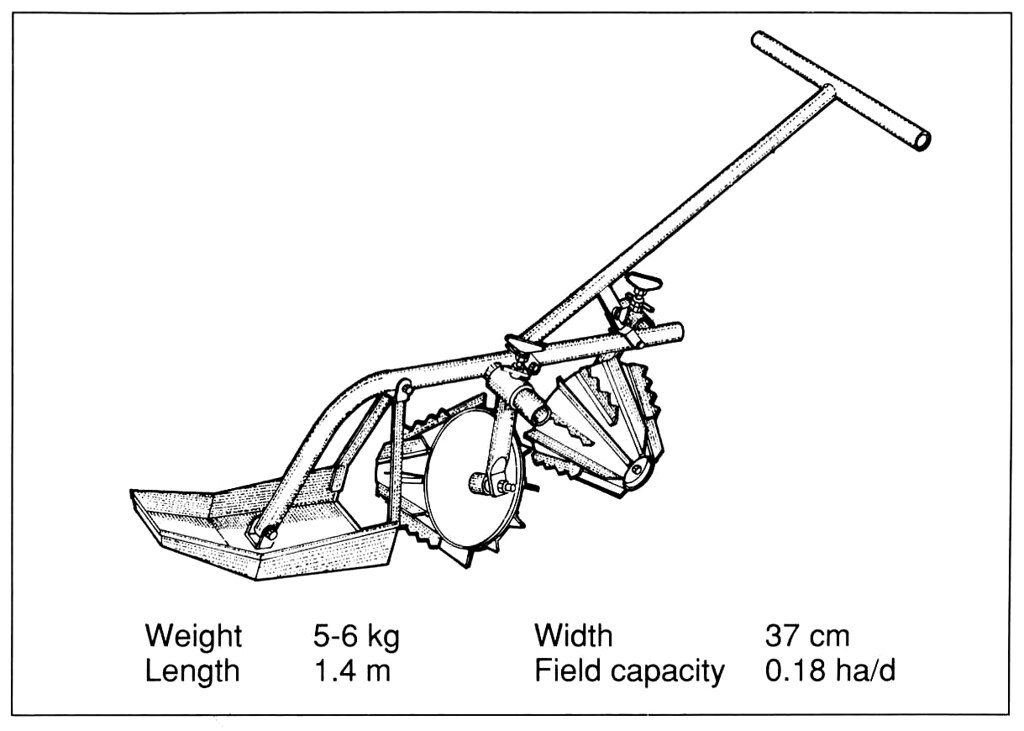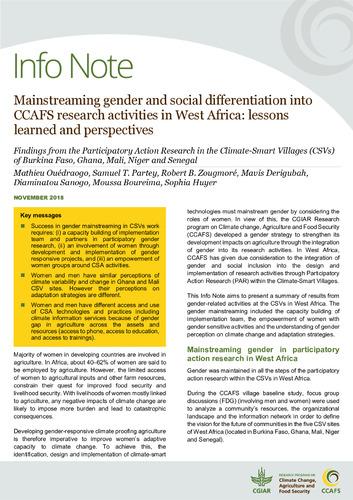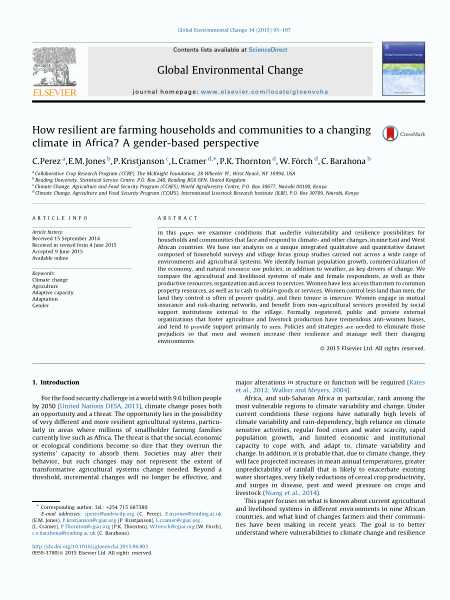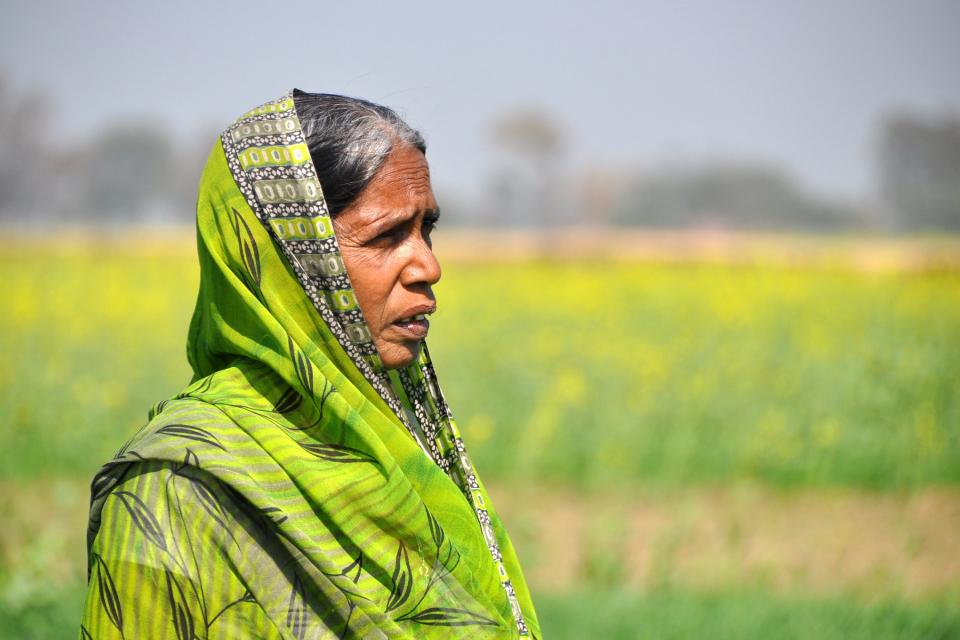Building farmers’ resilience to climate change means addressing gender inequalities
 Photo: Prashanth Vishwanathan/CCAFS.
Photo: Prashanth Vishwanathan/CCAFS.
Key messages:
- Women farmers are less able to adapt to climate change than men as they have less access to information, technology and decision-making and greater workloads.
- Women need to be supported to adopt climate adaptation and mitigation strategies if we are to meet the 2°C target for warming set by the United Nations Framework Convention on Climate Change.
- Gender equality and resilience for all can be achieved by focusing on four dimensions: increasing women’s decision-making ability, reducing their work burdens, increasing their access to resources, and supporting their collective action.
Climate change increases food security risks. It does this by decreasing access to water, increasing the incidence of heatwaves, causing heavy rainfalls and shifting agricultural zones. Climate change also intensifies social and gender inequality across the globe. Women have less access to resources, information and early warning systems. They have fewer opportunities to participate in decisions that affect their lives or to move to less impacted areas.
Women are stereotyped as victims of climate change impacts, while the structural causes of gender inequalities that cause vulnerability are ignored.
In a 2°C (or more) warmer world, gender equality hinges on increased resilience, meaning increasing the ability of everyone to respond climate change’s challenges. Resilience means everyone—women, men and their communities—can avoid, cope with or recover from climate change’s shocks and stresses.
The approaches we take to mitigate and adapt to climate change need to address women’s and men’s vulnerabilities. We need to promote everyone’s capacity for resilience, but need to particularly support women in responding to climate change impacts. If we fail, warming may increase beyond the 2°C target, while gender inequality will increase worldwide.
Four dimensions for achieving gender equality in climate-resilient agriculture
In a review of literature and approaches from four regions (East and West Africa, South and Southeast Asia), we identified four critical dimensions for achieving gender equality in climate-resilient agriculture:
- Ensuring women participate in decision-making at all levels
- Reducing women’s work burden
- Providing women with access to and supporting their use of resources, such as agroclimatic information, technology, livelihood incomes and credit
- Supporting collective action.
These four dimensions need to be considered by decision-makers, implementers, researchers and farmers when taking steps to mitigate and adapt to climate change.
Our review found that across regions, women have less access to family labor and basic agricultural technologies. However, climate impacts, such as drought and deforestation, are expected to substantially increase women’s workload. We need approaches to climate action that reduce women’s workloads.
Women need information, services and opportunities to build their capacity if they are to cope with and manage climate risk and variability. Women need initiatives that promote their participation in household decision-making and increase their access to resources. Women’s collective action will generate initiatives that suit their own needs and constraints, and ensure their voices are heard.
Gender equity increases livelihoods, incomes and community resilience
We found that focusing on a combination of two or more of the four dimensions will generate momentum for gender equality.
For example, in the climate-smart village of Daga-Birame in Senegal, a collective action and technology training approach, devised by the CGIAR Research Program on Climate Change, Agriculture and Food Security (CCAFS), the following collective action interventions were implemented:
- women and men participated equally on a local forest management committee, meaning women participated in village decision-making
- the women’s group set up a microenterprise to process and sell fruit powder made from local baobab trees
- a savings pool invested in community resilience activities.
As a result, women’s control over livelihood revenue as well as forest management and environmental conservation increased, their participation in community decision-making increased and children’s school enrollments increased.
In another example in India, CGIAR worked with women-led organizations to build their capacity to use climate-smart farming technologies and practices and to access climate information services. This project prioritized participation of women’s self-help groups (SHGs), while strengthening women’s agency and voice.
The SHGs participated in village climate management committees to manage and implement climate-smart agriculture. Women-led custom-hiring centers were set up to rent out climate-smart technologies. Several technologies reduced women’s work in the labor-intensive activities of weeding (cono-weeder), water management (solar pumps) and harvesting (harvesting machine).

A cono-weeder is used to efficiently remove weeds between rows of paddy crop, such as rice. Photo: IRRI.
Women farmers became aware of and implemented new practices learned through agro-advisory and weather information services. They expanded their information networks, regularly using advisories on weather, markets, crop cultivation and technologies. They also participated equally—or in some cases more than men—in capacity-building, technology prioritization and community consultations.
Collective action became a platform for gender equality, agency and resilience. Women gained better access to information, their production increased, their workloads decreased and they played a leading role in community decision-making. A survey in the wider region one year after the project began, found the average household income generated from rice and wheat production increased from 44 to 50 percent.
Unanswered questions and lessons for the future
Our review points to the need for greater gender equality to achieve climate resilient solutions. But there is still more we need to know, including:
- The role of capacity building and access to agro-climatic information in promoting and supporting gender equality
- The role of women’s collective action in building gender equality in climate-resilient agriculture
- How climate-smart technologies contribute to labor-saving outcomes for women, along with the reasons for women’s use—or not—of these technolgies
- The impacts of climate change on men, and their experience and responses to climate change in the context of masculinities
Achieving the goal of limiting global warming to 2°C in the next two decades will require large-scale expansion of climate-resilient approaches in agriculture, food systems and land management. We must explore how to scale these approaches, while achieving gender equality.
Climate change has different effects on women and men farmers, and therefore climate adaptation and mitigation strategies can perpetuate or even exacerbate gender inequalities. We need to build on and learn from past experiences and research to develop gender-responsive approaches that promote equality, while increasing resilience for all.
Suggested citation:
Huyer, S. 2021. Building farmers’ resilience to climate change means addressing gender inequalities. CGIAR GENDER Platform Evidence Explainer. Nairobi, Kenya: CGIAR GENDER Platform. https://hdl.handle.net/10568/114266.
References

Advancing gender equality through agricultural and environmental research: Past, present, and future
Pyburn, Rhiannon, ed.; and van Eerdewijk, Anouka, ed. 2021. Advancing gender equality through agricultural and environmental research: Past, present, and future. Washington, DC: International Food Policy Research Institute (IFPRI). https://doi.org/10.2499/9780896293915

Integrating Gender into the Climate-Smart Village Approach of Scaling out Adaptation Options in Agriculture

Gender and Climate Change: An Introduction
Dankelman, I. (2010). Gender and Climate Change: an Introduction. Routledge.

Can we turn the tide? Confronting gender inequality in climate policy

Mainstreaming gender and social differentiation into CCAFS research activities in West Africa: lessons learned and perspectives

How resilient are farming households and communities to a changing climate in Africa? A gender-based perspective

Advancing gender equality through agricultural and environmental research: Past, present, and future
Pyburn, Rhiannon, ed.; and van Eerdewijk, Anouka, ed. 2021. Advancing gender equality through agricultural and environmental research: Past, present, and future. Washington, DC: International Food Policy Research Institute (IFPRI). https://doi.org/10.2499/9780896293915

